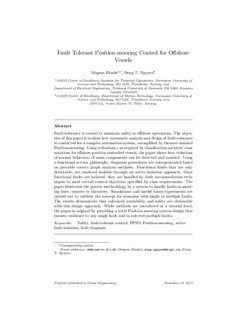| dc.contributor.author | Blanke, Mogens | |
| dc.contributor.author | Nguyen, Dong Trong | |
| dc.date.accessioned | 2017-11-27T09:04:46Z | |
| dc.date.available | 2017-11-27T09:04:46Z | |
| dc.date.created | 2017-11-25T15:00:08Z | |
| dc.date.issued | 2018 | |
| dc.identifier.citation | Ocean Engineering. 2018, 148 (jan), 426-441. | nb_NO |
| dc.identifier.issn | 0029-8018 | |
| dc.identifier.uri | http://hdl.handle.net/11250/2468095 | |
| dc.description.abstract | Fault-tolerance is crucial to maintain safety in offshore operations. The objective of this paper is to show how systematic analysis and design of fault-tolerance is conducted for a complex automation system, exemplified by thruster assisted Position-mooring. Using redundancy as required by classification societies' class notations for offshore position controlled vessels, the paper shows how violations of normal behaviour of main components can be detected and isolated. Using a functional service philosophy, diagnosis procedures are auto-generated based on provable correct graph analysis methods. Functional faults that are only detectable, are rendered isolable through an active isolation approach. Once functional faults are isolated, they are handled by fault accommodation techniques to meet overall control objectives specified by class requirements. The paper illustrates the generic methodology by a system to handle faults in mooring lines, sensors or thrusters. Simulations and model basin experiments are carried out to validate the concept for scenarios with single or multiple faults. The results demonstrate that enhanced availability and safety are obtainable with this design approach. While methods are introduced at a tutorial level, the paper is original by providing a total Position-mooring system design that ensures resilience to any single fault and to selected multiple faults. | nb_NO |
| dc.language.iso | eng | nb_NO |
| dc.publisher | Elsevier | nb_NO |
| dc.rights | Attribution-NonCommercial-NoDerivatives 4.0 Internasjonal | * |
| dc.rights.uri | http://creativecommons.org/licenses/by-nc-nd/4.0/deed.no | * |
| dc.title | Fault-tolerant Position-Mooring Control for Offshore Vessels | nb_NO |
| dc.type | Journal article | nb_NO |
| dc.type | Peer reviewed | nb_NO |
| dc.description.version | acceptedVersion | nb_NO |
| dc.source.pagenumber | 426-441 | nb_NO |
| dc.source.volume | 148 | nb_NO |
| dc.source.journal | Ocean Engineering | nb_NO |
| dc.source.issue | jan | nb_NO |
| dc.identifier.doi | 10.1016/j.oceaneng.2017.11.042 | |
| dc.identifier.cristin | 1518370 | |
| dc.relation.project | Norges forskningsråd: 223254 | nb_NO |
| dc.description.localcode | © 2017. This is the authors’ accepted and refereed manuscript to the article. LOCKED until 24.11.2019 due to copyright restrictions. This manuscript version is made available under the CC-BY-NC-ND 4.0 license http://creativecommons.org/licenses/by-nc-nd/4.0/ | nb_NO |
| cristin.unitcode | 194,63,25,0 | |
| cristin.unitcode | 194,64,20,0 | |
| cristin.unitname | Institutt for teknisk kybernetikk | |
| cristin.unitname | Institutt for marin teknikk | |
| cristin.ispublished | true | |
| cristin.fulltext | original | |
| cristin.fulltext | postprint | |
| cristin.qualitycode | 1 | |

